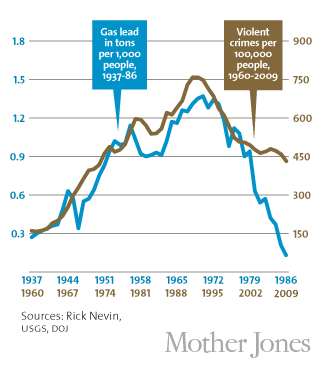I’ve written several posts recently about the idea that America’s great crime epidemic, which started in the 60s and peaked in the early 90s, was caused in large part by lead emissions from automobiles. Long story short, we all bought lots of cars after World War II and filled them up with leaded gasoline. This lead was spewed out of tailpipes and ingested by small children, and when those children grew up they were more prone to committing violent crimes than normal children. Then, starting in the mid-70s, we all began switching to unleaded gasoline. Our kids were no longer made artificially violent by lead poisoning, and when they grew up in the mid-90s they committed fewer violent crimes. This trend continued for two decades, and it’s one of the reasons that violent crime rates have dropped by half over the past 20 years and by more than that in our biggest cities. It’s one of the great underreported stories of our time: big cities today are as safe as they were 50 years ago.
That’s the short version of the story. The long version of the story is on the cover of the current issue of Mother Jones, and today it’s available online for the first time. Click here to read it. The chart on the right illustrates the basic data that inspired the lead hypothesis: it shows lead emissions starting in 1935 overlaid with the violent crime rate 23 years later. The two curves match almost perfectly.
Now, I know my readers, and first thing a lot of you are going to do is yell at me: “Correlation is not causation!” And that’s true. If this curve were the only bit of evidence we had, the  connection between lead and violent crime would be pretty thin. But it’s not. You should read the story to understand just how many different studies confirm this relationship. In addition, over the last decade there’s been a tsunami of new medical research about just what lead poisoning—even at very low levels—does to children. It lowers IQ, of course, but it does a lot more than that:
connection between lead and violent crime would be pretty thin. But it’s not. You should read the story to understand just how many different studies confirm this relationship. In addition, over the last decade there’s been a tsunami of new medical research about just what lead poisoning—even at very low levels—does to children. It lowers IQ, of course, but it does a lot more than that:
Not only does lead promote apoptosis, or cell death, in the brain, but the element is also chemically similar to calcium. When it settles in cerebral tissue, it prevents calcium ions from doing their job, something that causes physical damage to the developing brain that persists into adulthood.
Only in the last few years have we begun to understand exactly what effects this has. A team of researchers at the University of Cincinnati has been following a group of 300 children for more than 30 years and recently performed a series of MRI scans that highlighted the neurological differences between subjects who had high and low exposure to lead during early childhood.
One set of scans found that lead exposure is linked to production of the brain’s white matter—primarily a substance called myelin, which forms an insulating sheath around the connections between neurons. Lead exposure degrades both the formation and structure of myelin, and when this happens, says Kim Dietrich, one of the leaders of the imaging studies, “neurons are not communicating effectively.” Put simply, the network connections within the brain become both slower and less coordinated.
A second study found that high exposure to lead during childhood was linked to a permanent loss of gray matter in the prefrontal cortex—a part of the brain associated with aggression control as well as what psychologists call “executive functions”: emotional regulation, impulse control, attention, verbal reasoning, and mental flexibility. One way to understand this, says Kim Cecil, another member of the Cincinnati team, is that lead affects precisely the areas of the brain “that make us most human.”
So lead is a double whammy: It impairs specific parts of the brain responsible for executive functions and it impairs the communication channels between these parts of the brain. For children like the ones in the Cincinnati study, who were mostly inner-city kids with plenty of strikes against them already, lead exposure was, in Cecil’s words, an “additional kick in the gut.”
We now have a huge amount of evidence linking lead to violent crime. We have evidence not just at the national level, but also at the state level, the city level, and the international level. We have longitudinal studies that track children from birth to adulthood to find out if higher blood lead levels lead to more arrests for violent crimes. And perhaps most important, this is a theory that just makes sense. Everything we now know about the effects of lead on the brain tells us that even moderately high levels of lead exposure are associated with aggressivity, impulsivity, ADHD, and lower IQ. And right there, you’ve practically defined the profile of a violent young offender.
You probably have a lot of questions about all this. What about other countries that eliminated leaded gasoline? Why haven’t I mentioned lead paint in old housing? Don’t things like policing tactics and increased incarceration matter too? And since leaded gasoline has been long since banned, why should you care about this? All these questions and more are answered if you read the full article.
I’ll have more about this over the next few days, including some interesting tidbits that didn’t make it into the magazine piece for one reason or another. It’s really pretty fascinating stuff. I hope you have as much fun reading about it as I did writing about it.


















